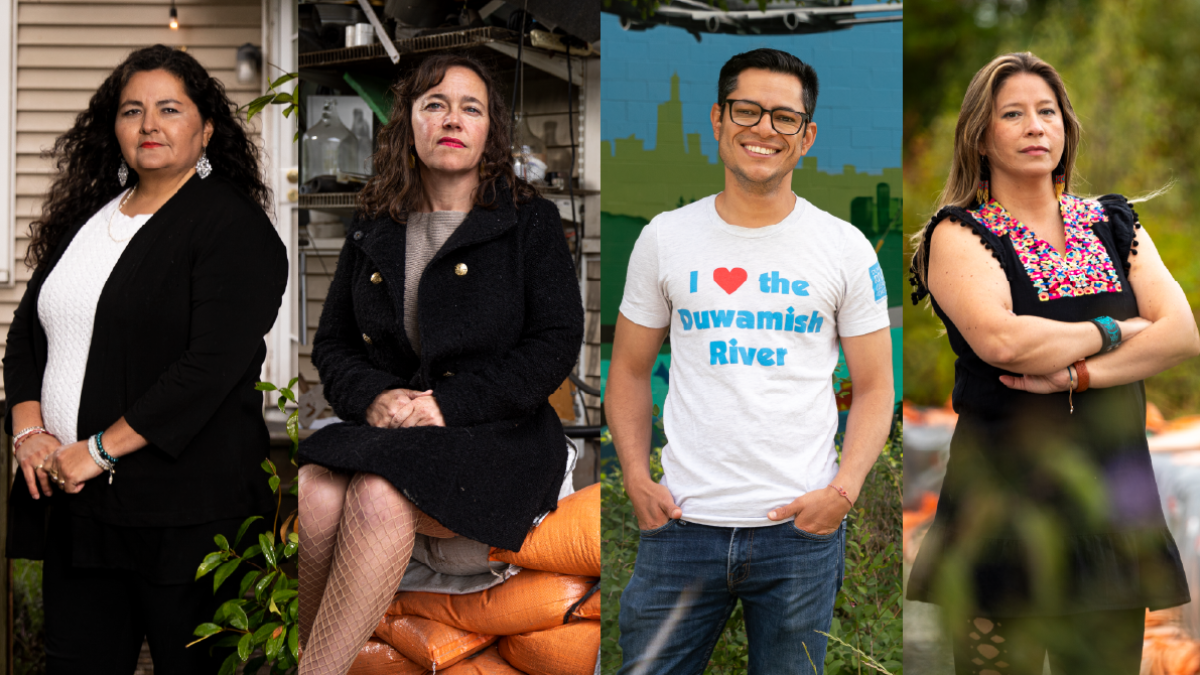
Contact: Nicole Errett, assistant professor, University of Washington Department of Environmental & Occupational Health Sciences: nerrett@uw.edu • Jamie Hearn, director of environmental law and climate policy, Duwamish River Community Coalition: jamie@drcc.org / 385-743-1051
SEATTLE (December 5, 2023) — In December 2022, floodwaters displaced dozens of South Park residents as the Duwamish River overtopped its banks. Homes, businesses and city streets were suddenly underwater as the year’s highest tides surged past predicted levels due to a confluence of heavy rains, atmospheric conditions and rising seas.
Almost a year later, several of those displaced families remain unable to return home, while storage pods holding damaged belongings still line the streets. Fresh rows of orange sandbags create a temporary bulwark against the swelling river as South Park prepares for a new season of King Tides this winter.
A new web-based “story map” combines the voices of people impacted by the 2022 flood with data about how the community is preparing for climate change from door-to-door surveys of residents.
The data was collected as part of a research partnership involving the University of Washington, the Duwamish River Community Coalition (DRCC) and the City of Seattle. Together, the stories and data help identify ways to mitigate climate change impacts and build resilience in Seattle’s Duwamish Valley.
In one story, Oscar Haney, a 17-year-old student at Chief Sealth High School, describes how scary it was to wake up to his mother yelling for them to get out of the house as the river came across their backyard.
“I jumped out of bed in shorts real quick,” he said, as the water started flowing into their basement. “It was like experiencing a major impact of climate change. That was one of the first things I thought. This is the climate crisis right here, and I’m living it.”
But rather than seeing himself as a victim, Oscar decided to do something. He joined the Duwamish Valley Youth Corps after seeing them help stack sandbags in his neighborhood to protect against King Tides.
“After that, I got to be on the other side, and it helped me feel like I’m more a part of my community.” Oscar’s story reinforces a key finding of the research survey: the majority of residents (64%) feel the Duwamish Valley has a strong sense of community, a key asset as these neighborhoods come together to prepare for future climate-related impacts.
Paulina López, DRCC’s executive director, helped design the door-to-door survey and contributed to the story map as part of the organization’s focus on environmental and climate justice.
“Climate Justice is the understanding that we must lead with collective community power and hold decision-makers accountable to eliminate unfair climate impacts on communities like the Duwamish Valley. The Duwamish Valley’s vulnerability to sea level rise, increasing temperatures, and air pollution mean that climate change events will have a greater impact on this community than on wealthier and healthier areas in Seattle,” said Jamie Hearn, DRCC’s director of environmental law and climate policy.
UW EDGE Center Community Engagement Core Director Nicole Errett, who led the UW team involved in the research, said, “Research led by communities that are experiencing the first and worst impacts of climate change can inform equitable and acceptable approaches to reducing risk. We are so grateful for the opportunity to support the Duwamish community in this important work."
The City of Seattle plans to use the survey data and stories of impacted community members to inform their efforts to strengthen community resilience in the face of climate change, including placing “Resilience Hubs” in the Duwamish Valley neighborhoods of Georgetown and South Park and developing a community-informed strategy to protect local residents and businesses against future floods as sea levels continue to rise.
“The City of Seattle is eager to apply the data yielded from community led research to directly inform critical solutions that advance climate justice. For example, our ongoing work with partners to establish a Resilience District in the Duwamish Valley and the development of community resilience hubs, aim to increase capacity within our neighborhoods to prepare for and respond to climate related events such as flooding” said Lylianna Allala, climate justice director at the City of Seattle Office of Sustainability and Environment.
To learn more about the climate resilience survey and story map, visit: https://deohs.washington.edu/edge/blog/resilience-seattles-waterfront